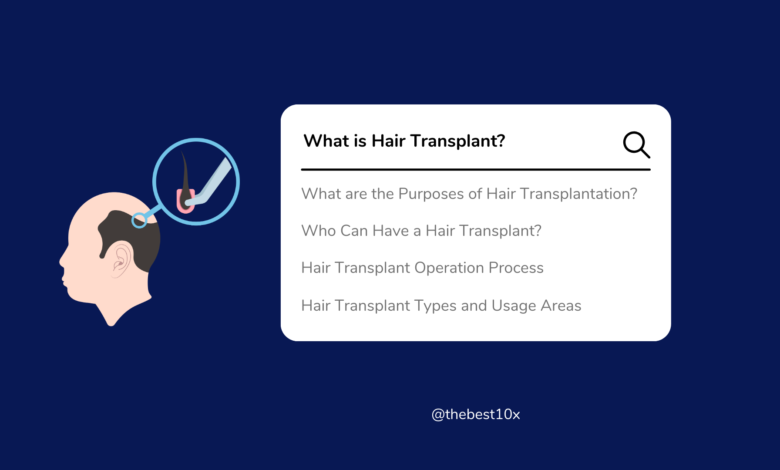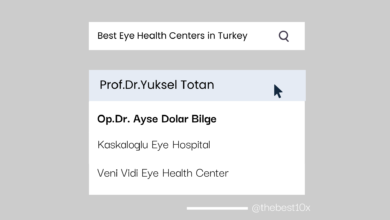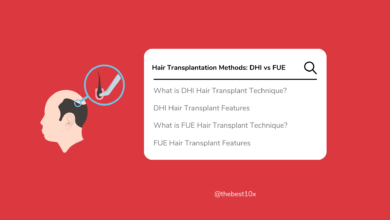
Hair transplantation is an aesthetic surgical procedure that offers a hopeful solution for many people suffering from hair loss or thinning hair. Hair transplantation is usually performed by transferring hair follicles from the donor area where hair follicles are taken to the areas that are sparse or bald. This method is popular with both men and women and helps to restore one’s hair aesthetics and self-confidence. However, hair transplantation is considered not only a surgical intervention, but also an art form, since it is in the hands of an experienced surgeon that a natural and aesthetic result is achieved. Read on to learn more about how hair transplantation is performed and the details of this important aesthetic procedure.
What Is Hair Transplantation?
Hair transplantation is a medical procedure used to provide thicker and fuller hair to individuals with hair loss or sparse hair problems. This procedure is usually performed by transplanting hair follicles taken from the donor area (usually the nape or lateral head areas), where the patient’s own hair follicles are taken, to the areas where hair loss or sparseness is experienced. Hair transplantation is a common cosmetic surgery method among both men and women and is used to restore the natural appearance of hair, correct the hairline or fill bald patches. This procedure is performed by a specialized surgeon or hair transplant specialist and carefully planned so that a natural and aesthetic result is achieved.
What Are The Purposes Of Hair Transplantation?
Hair transplantation is a surgical procedure performed to restore or improve the hair of individuals suffering from hair loss or sparse hair. This procedure aims to reduce the aesthetic and psychological effects of hair loss and restore the person’s hair aesthetics.
Here are the main purposes of hair transplantation:
Increasing Hair Density: Hair transplantation makes sparse hair areas more dense, making the hair look fuller and thicker. This significantly improves the aesthetics of one’s hair.
Correcting the Hairline: Hair transplantation can be used to correct or recreate the hairline. This is important to achieve a more harmonious look with the other features of the face.
Natural and Aesthetic Results: Hair transplant specialists aim to achieve aesthetically pleasing results by placing hair follicles at natural angles and mimicking natural hair growth patterns. This makes the hair transplant unnoticeably natural.
Boosting Self-Confidence Hair loss can lead to a loss of self-confidence for many people. Hair transplantation can help regain self-confidence by restoring hair.
Functionally Effective: During hair transplantation, hair follicles taken from the donor area are transplanted to the areas where hair loss occurs, while the hair in the donor area is expected to grow again. This procedure aims to achieve lasting results.
Hair transplantation offers an effective way to improve one’s aesthetic and psychological well-being. However, this procedure should be carefully planned and performed by a specialized hair transplant surgeon. Each patient’s needs are different, so a personalized approach is necessary.
Who Can Have A Hair Transplant?
Hair transplantation offers an effective surgical solution for individuals who experience hair loss and want to increase hair density or address aesthetic concerns. However, it is important that people considering this procedure meet certain criteria. Here is detailed information about suitable candidates and unsuitable candidates for hair transplantation:
| Status / Criteria | Eligible Candidates | Ineligible Candidates |
Aesthetic Concerns | -People with hair loss or sparse hair problems -People who want to increase hair density or improve sparse hair areas | – |
Functional Problems | -People whose donor site is healthy and suitable | – People who do not have a suitable donor area for hair transplantation or who have insufficient donor area |
Age Factor | – People with complete body development | – Children with incomplete body development, persons under 18 years of age |
Health Status | -People who do not have a health condition that may prevent surgery | -People with serious chronic health problems or a health problem that will prevent surgery |
Realistic Expectations | -Hair transplant candidates should expect realistic results after surgery. -Hair transplantation makes existing hair denser, but does not completely prevent hair loss. | -People who expect surreal results from surgery |
Psychological Preparation | People who are psychologically prepared for the pre- and post-operative process | -People who have not prepared their psychology for the operation process, those who are in the process of psychological treatment. |
Since each person has different needs and expectations, a customized assessment should be made for suitable candidates for hair transplantation. For this reason, it is important for people considering hair transplantation to consult with a specialized hair transplant surgeon and make a plan that suits their personal situation.
Hair Transplant Operation Process
Hair transplantation is a surgical procedure preferred by individuals with hair loss to increase hair density or to correct hairlines. This operation consists of a series of steps and is performed by a specialized hair transplant surgeon.
Here are the steps of the hair transplant operation process:
Pre-Operational Consultation and Evaluation Process
Before starting a hair transplant operation, patients should consult with a specialized hair transplant surgeon. During this process, the surgeon evaluates the patient’s hair loss condition, examines the hair density and the causes of hair loss. It also evaluates whether the patient is a suitable candidate for hair transplantation. The patient’s expectations and wishes are also discussed in detail at this stage.
Donor Site Selection
For hair transplantation, the donor area to receive hair follicles is determined. This area is usually the nape of the neck because the hair follicles here are genetically resistant to hair loss. The surgeon carefully selects the hair follicles to be taken from this area.
Anesthesia Application
On the day of the operation, the patient is given local or general anesthesia. This ensures that the patient does not feel pain or discomfort during the operation.
Removal of Hair Roots
Hair follicles from the donor area are carefully removed. Today, FUE (Follicular Unit Extraction) is the most widely used method. With this method, hair follicles are removed one by one, which speeds up the healing process and minimizes surgical scars.
Opening of Channels
The hair follicles are transplanted to the areas where they will be transplanted through properly prepared channels or holes. This stage gives the hair a natural look.
Transplantation of Hair Roots
The hair transplant surgeon transplants the hair follicles one by one to the designated areas. Transplanting hair at the right angle and density ensures successful results.
Post Operative Care
After the operation, the patient is given instructions to protect the hair transplantation area. These instructions are intended to reduce the risk of infection, control swelling and bruising and promote healthy hair follicles.
Recovery Process
Swelling and bruising are normal in the first few days after the operation. However, these symptoms diminish over time. Hair transplant results usually become fully visible within 6-12 months.
Hair transplantation is an effective option to improve the hair density and aesthetic appearance of individuals with hair loss. However, for the operation to be successful, it is important for the patient to pay attention to the post-operative care instructions as well as a specialized surgeon.
Hair Transplant Types and Usage Areas
Hair transplantation is an effective method used in the treatment of hair loss and has different types and areas of use. These methods may vary depending on the cause of hair loss, the patient’s needs and surgical preferences.
Here are the types of hair transplantation and the situations in which it is applied:
FUE (Follicular Unit Extraction)
The FUE method is the most widely used and minimally invasive technique in the field of hair transplantation. In this method, hair follicles are extracted one by one from the donor area and transplanted to the recipient area. FUE speeds up the post-operative recovery process and minimizes scars. It is generally preferred for the treatment of baldness in men.
FUT (Follicular Unit Transplantation)
The FUT method is a technique in which the skin is removed in the form of a strip and hair follicles are extracted. With this method, larger amounts of hair follicles can be collected. However, postoperative suture scars may be permanent. The FUT method is used especially in cases where hair transplantation is required in large areas.
DHI (Direct Hair Implantation)
DHI is a method in which hair follicles are transplanted directly into the recipient area. Using a special device, hair follicles are harvested and transplanted immediately. With this method, stitches or incisions are minimal and the healing process is fast. DHI is preferred for hairline correction or density enhancement.
Hair Eyebrow Transplant
Hair transplantation is not only used for the scalp, but also for reshaping or intensifying the eyebrows. Especially for those who have sparse eyebrows or who have lost their eyebrows, hair eyebrow transplantation is an important option.
Hair and Beard Transplant
Beard transplantation is suitable for men who want to achieve a more dense and regular beard appearance. Hair follicles can be transplanted into the beard area to create the desired beard shape.
Each hair transplant method is determined by the needs of the patient and the causes of hair loss. A detailed evaluation by an expert hair transplant surgeon helps to choose the most suitable type of hair transplant. Hair transplantation is an effective treatment option that offers successful results in terms of aesthetics and safety for individuals struggling with hair loss.
Post Hair Transplant Care and Recovery Process
After the hair transplant operation, a careful recovery and care process is necessary to achieve successful results and prevent any complications.
Here is what you need to know in the post-hair transplant period:
Early Days
Immediately after the operation, protection is provided with bandages and gauze applied to the head area. You should keep your head in a lying position for the first 24 hours. Keeping your head elevated when lying down helps reduce swelling and bruising.
Swelling and Bruises
Swelling and bruises in the head area are normal after hair transplantation. These symptoms usually subside within a few days. You can relieve swelling by using cold compresses.
Pain and Discomfort
A slight pain or discomfort after the operation is normal. You will be able to get relief by regularly using the painkillers recommended by your doctor.
Bandages and Scars
You must keep the bandage and stitches on your head for the time specified by your doctor. These bandages and stitches help the hair follicles to settle and the skin to heal.
Hair Washing
You may need to avoid washing your hair for a certain period of time after the operation. You can start washing your hair after the time recommended by your doctor.
Nutrition and Activity
After hair transplantation, it is important to follow a light diet and avoid excessive physical activity. You should focus on resting for the time recommended by your surgeon.
Doctor Check-ups
Regular post-operative medical check-ups ensure that the healing process is monitored. Your doctor is there to explain the hair transplant results and answer any questions you may have.
Hair Care
Towards the end of the healing process, you should take care of your hair as recommended by your doctor. Using special hair care products and gently cleansing the scalp promotes healthy growth of the hair follicles.
Patience and Expectations
It may take time for full results to appear after hair transplantation. You must be patient and wait. During the first few months, hair follicles may fall out, but new hair will start to grow at the end of this process.
Sun Protection
It is important to pay attention to sun protection in the post-hair transplant period to preserve the color of the operation scars and protect the head area from harmful effects.
Remember that each individual’s healing process may differ. Strictly following your doctor’s instructions, reaching out to your doctor when necessary and taking regular care after hair transplantation is one of the most important steps for a healthy and successful recovery process.
Frequently Asked Questions
Is hair transplantation a painful procedure?
Hair transplantation is usually performed under local anesthesia, so no pain is felt. There may be mild pain or discomfort after surgery, but these can be controlled with painkillers prescribed by the doctor.
How long does the healing process take after hair transplantation?
The healing process after a hair transplant can vary from person to person, but usually starts with bandages and scabs in the first few days. Tam iyileşme ve sonuçların görünmesi birkaç ay sürebilir.
Are hair transplant results permanent?
Yes, hair transplant results are usually permanent. Transplanted hair follicles usually provide permanent hair growth. Transplanted hair follicles usually provide permanent hair growth.
Since rhinoplasty, like hair transplantation, is a surgery that greatly affects the appearance of the person, the choice of surgeon is extremely critical. Choosing an appropriate surgeon ensures that the desired results are achieved and the risk of complications is minimized. Therefore, it is very important to choose an experienced and specialized plastic surgeon. A professional surgeon understands the individual’s specific needs and goals, makes a personalized surgical planning and performs the surgery in the safest way. When choosing a surgeon, you should pay close attention to their references, experience and success stories. This is a critical decision that will help improve your satisfaction after surgery. Therefore, doing a good research for the best hair transplant doctors is an important step before surgery.




